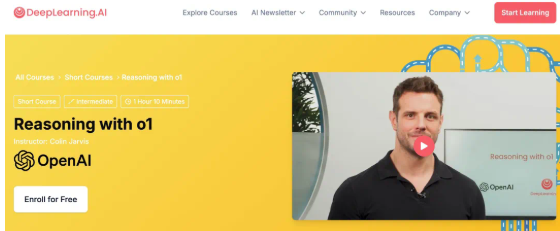OpenAI joins hands with Professor Andrew Ng, a leading figure in the field of artificial intelligence, to launch a free course "Reasoning with o1", taught by Colin Jarvis, OpenAI's director of strategic solution architecture. This course is designed to help developers learn in depth about the advanced reasoning capabilities of the o-series models, a new generation of AI models launched by OpenAI in 2024. The o-series models handle complex problems through a deeper "thinking" process, and excel in multi-step planning, image reasoning, and long-term encoding. The course content covers the basic knowledge of o1 real-time engineering, multi-step task planning, code creation and editing, image reasoning, and Metaprompting technology. It also includes coding competitions and practical sessions to help students master the application and performance tuning of o1 models.

Course address: https://www.deeplearning.ai/short-courses/reasoning-with-o1
The o series model is a new generation of AI models launched by OpenAI in 2024. Compared with traditional large language models, the most significant feature of this series is that it handles complex problems through a deeper "thinking" process. By performing thought chain analysis during inference, o-series models demonstrate excellent performance in emerging application scenarios such as multi-step planning, image reasoning, and long-term encoding.
The course content is comprehensive and systematic, covering the basic knowledge of o1 real-time engineering, multi-step task planning and execution, code creation and editing, image reasoning, and Metaprompting technology that can improve model performance. Students can not only gain an in-depth understanding of the working principle and performance characteristics of o1, but also master how to weigh the use of different models in practical applications to achieve optimal cost-effectiveness.
It is particularly worth mentioning that the course will explain in detail how OpenAI uses reinforcement learning to build a model with "test-time calculation" capabilities, and how "thinking chain" prompts help o1 autonomously decompose complex problems into manageable small steps. In the practical session, students will learn how to use o1 as a coordinator to work with the 4o-mini model to balance intelligent performance and cost.
In addition, the course also includes a coding competition, which helps students more intuitively understand the performance differences of different models through comparative testing between o1-mini and GPT4o. In terms of image understanding, the course will introduce how o1 achieves better performance through hierarchical reasoning.
The launch of this free course not only reflects OpenAI's emphasis on AI education, but also provides developers with an excellent opportunity to deeply understand and master the new generation of AI models. For developers who want to stay competitive in the field of AI application development, this is undoubtedly a learning opportunity not to be missed.
All in all, this course is rich in content and practical, and is a valuable resource for learning and mastering the O1 model and its applications. Whether you are an experienced developer or a novice in the AI field, you can benefit a lot from it and improve your competitiveness in the AI field. Seize the opportunity, learn for free, and start your AI journey!